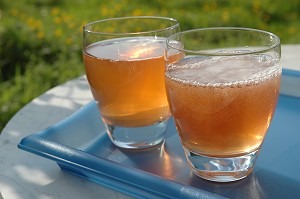
Kombucha
Introduction
This fact sheet provides basic information about Kombucha. Kombucha is not a fungus or a mushroom, but rather a gray, pancake-shaped patty that grows up to six inches in diameter. The patty is placed in a mixture of black tea and sugar to ferment. Technically, the fermentation becomes a mixture of yeast and bacteria (ie, Bacterium xylinum , Bacterium gluconicum , Acetobacter ketogenum and Pichia fermentans).Kombucha tea has grown rapidly in popularity over the past year and has been touted as a miracle cure for a wide variety of illnesses, ranging from memory loss to premenstrual syndrome.
The name kombucha is derived from the Japanese in that it is brewed in a seaweed (kombu) tea (cha). In Western countries, the product is typically propagated in black tea. Users float growing spores on the surface of brewed, sweetened black tea. The mycelium double in mass approximately every week. The mass is then divided and the new portion is propagated on a new tea media. In this manner, kombucha mycelium can be propagated at a rapid rate for commercial distribution. Units of the fungus can sell for $50 each.
As the growth matures, it ferments the beverage slightly. This fermented tea is drunk for its purported medicinal properties. Drinking fermented teas has long been popular in Eastern countries, and the use of this particular mycelial growth may date back several centuries.
Despite extravagant claims for its pharmacologic activity, some experts believe that the tea fulfills the FDA criteria identifying a fraudulent product, including: reference to non-US medical studies, an appeal to a person's vanity, ancient origins and alleged cures for a wide variety of ailments. Some of these claims include curing cancer, rheumatism, aging and intestinal disorders.
Common Names
Kombucha, Kombucha Tea, Kombucha Mushroom, Manchurian Tea, Combucha tea, Spumonto, Tschambucco, Teekwass, Kwassan, Kargasok Tea, "Fungus" Japonicus, Manchurian "Fungus", Dr. Sklenar's Kombucha Mushroom Infusion, Champagne of Life, T'Chai from the SeaWhat It Is Used For
- There is no good evidence to support the pharmacologic claims for kombucha.
- The strongest endorsement of the power of Kombucha tea is that cultures throughout the world have been using it for hundreds, perhaps thousands, of years in different parts of the world. This in itself lends testimony to the fact the tea has long been beneficial to many for a variety of physical ailments.
How It Is Used
Kombucha is most commonly taken as a tea and is prepared by incubating it in sugared black or green tea. The tea is mildly effervescent and has a cider-like acid taste.What the Science Says
- There is no good evidence to support the pharmacologic claims for kombucha. Because kombucha tea is a product of bacterial fermentation, it may contain compounds that affect the bacterial flora of the gut.
- One report on Dr. Sklenar's kombucha mushroom infusion (1960s) as a cancer therapy indicated that there was no solid medical data available on its usefulness in cancer treatment. Screening of "Kargasok tea" (kombucha tea) for anorexia and obesity has also been reported, but not validated.
Side Effects and Cautions
- None well documented.
Sources
- Drugs.Com Web site. Accessed on February 7, 2009.
- From Wikipedia, the free encyclopedia. Accessed on February 7, 2009.






